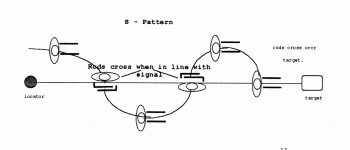lesjcbs
Hero Member
- Jul 14, 2011
- 880
- 338
- Detector(s) used
- Pocket dowsing L- Rods shown above. Whites Beach Comber, Bounty Hunter Sharp Shooter II, Whites TM 808, Canon 350D EOS Digital Rebel XT DSLR Camera.
- Primary Interest:
- Metal Detecting
At a very large public park, I walked up to a man using his Garrett metal detector (MD) to find targets in the ground. I told him I dowse for targets then pin point it with my MD. He looked at me with a puzzled look. I asked him if he dowses and he said: “no” We talked a few minutes about our MD's then we parted.
I went to another area of the park and from a distance, I took a few moments to watch him work. As I did, I noticed something very familiar that I had not noticed, considered or even thought about before. As he slowly walked along, swinging his detector back and forth in the usual manner when one uses an MD to detect metal targets, he would suddenly stop, bend down, and dig out an unseen target in the ground. Sometimes he did not bend down and dig, but would stop and thoroughly search the spot, then continued his searching.
All during his searching, I noticed his path of travel would vary from straight ahead, then to the right,then to the left, then maybe straight again, then over here, then to over there etc. It looked like something invisible was guiding or urging him to go in each direction.
When field dowsing with L-Rods, if we dowse long range, we go in the direction our rod / s points. As we walk along in that direction , if our rod starts turning to the right, we go right, if it turns left we go left, if it keeps pointing straight ahead, we continue going straight. We change directions ONLY when the rod indicates to change and we continue on until it indicates to stop. Now, like MD users, while dowsing, all this happens when we cannot see the target with our naked eye. The only time both the MD users and dowsers gets to see the target is when we dig it out of the ground.
So, for the dowser, it is crystal clear, the rods points in the direction we need to go and when to stop and dig..
I now have a question: What prompts, urges, or stimulates the one using an MD ONLY to go over there, or over here, then somewhere else to find unseen targets in the ground?
I went to another area of the park and from a distance, I took a few moments to watch him work. As I did, I noticed something very familiar that I had not noticed, considered or even thought about before. As he slowly walked along, swinging his detector back and forth in the usual manner when one uses an MD to detect metal targets, he would suddenly stop, bend down, and dig out an unseen target in the ground. Sometimes he did not bend down and dig, but would stop and thoroughly search the spot, then continued his searching.
All during his searching, I noticed his path of travel would vary from straight ahead, then to the right,then to the left, then maybe straight again, then over here, then to over there etc. It looked like something invisible was guiding or urging him to go in each direction.
When field dowsing with L-Rods, if we dowse long range, we go in the direction our rod / s points. As we walk along in that direction , if our rod starts turning to the right, we go right, if it turns left we go left, if it keeps pointing straight ahead, we continue going straight. We change directions ONLY when the rod indicates to change and we continue on until it indicates to stop. Now, like MD users, while dowsing, all this happens when we cannot see the target with our naked eye. The only time both the MD users and dowsers gets to see the target is when we dig it out of the ground.
So, for the dowser, it is crystal clear, the rods points in the direction we need to go and when to stop and dig..
I now have a question: What prompts, urges, or stimulates the one using an MD ONLY to go over there, or over here, then somewhere else to find unseen targets in the ground?
Amazon Forum Fav 👍
Last edited:


 Meanwhile, other people will drop things wherever they land, with nothing having any real, designated place. ...Remember the show The Odd Couple?
Meanwhile, other people will drop things wherever they land, with nothing having any real, designated place. ...Remember the show The Odd Couple?




